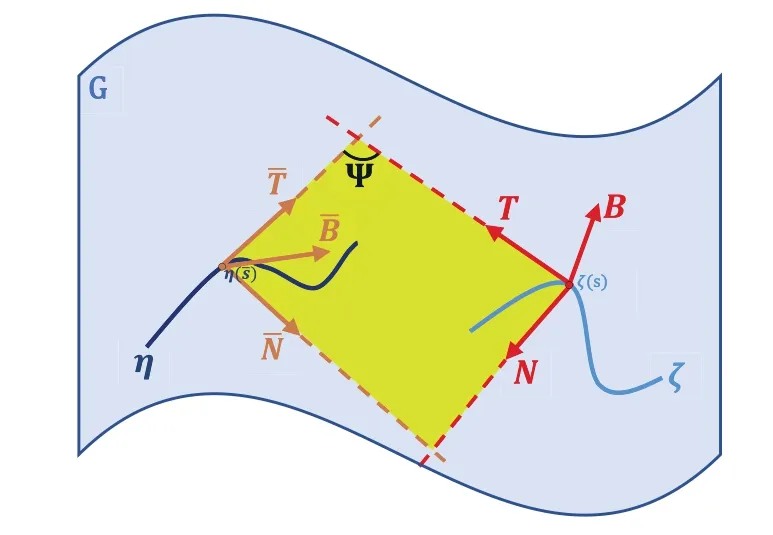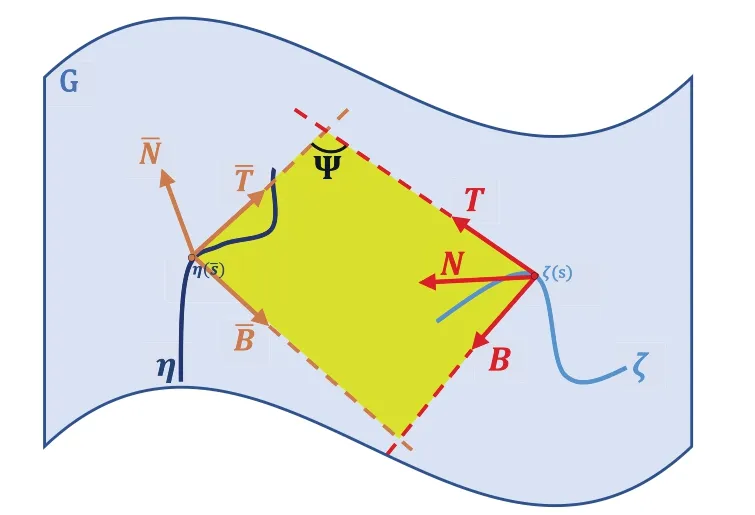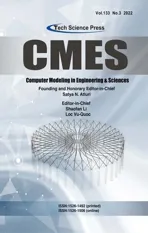Frenet Curve Couples in Three Dimensional Lie Groups
2022-02-25OsmanZekiOkuyucu
Osman Zeki Okuyucu
Department of Mathematics,Faculty of Science and Arts,Bilecik¸Seyh Edebali University,Bilecik,Turkey
ABSTRACT In this study, we examine the possible relations between the Frenet planes of any given two curves in three dimensional Lie groups with leたinvariant metrics.We explain these possible relations in nine cases and then introduce the conditions that must be met to coincide with the planes of these curves in nine theorems.
KEYWORDS Curves;lie groups;curvatures;Frenet plane
1 Introduction
The theory of curves has an important role in differential geometry studies.In the theory of curves,one of the interesting problems is to investigate the relations between two curves.The Frenet elements of the curves have an effective role in the solution of the problem.
For example,if the principal normal vectors coincide at the corresponding points of the curvesαandβ, the curve couple {α,β} is called the Bertrand curve couple in a three-dimensional Euclidean space[1,2].Similarly,if tangent vectors coincide,the curve couple{α,β}is called the involute-evolute curve couple.Also,if the normal vector of the curveαcoincides with the bi-normal vector of the curveβ,the curve couple{α,β}is called the Mannheim curve couple[3].
In a three-dimensional Lie groupGwith a bi-invariant metric,Çiftçi has defined general helices[4].Also Okuyucu et al.have obtained slant helices and Bertrand curves inG[5,6].Gök et al.have investigated Mannheim curves inG[7].Recently, Yampolsky et al.have examined helices in three dimensional Lie groupG,with left-invariant metric[8].Also,many applications of curves theory are studied and still have been investigated in three dimensional Lie groups(see[9-12],etc.).
Karaku¸s et al.have examined the possibility of whether any Frenet plane of a given space curve in a three-dimensional Euclidean space is also any Frenet plane of another space curve in the same space[13].
In this study,we examine the possible relations between the Frenet planes of given two curves in three dimensional Lie groups with left invariant metrics.
2 Preliminaries
LetGbe a three dimensional Lie group with left-invariant metric 〈,〉 and let g denote the Lie algebra ofGwhich consists of the all smooth vector fields ofGinvariant under left translation.There are two classes of three dimensional Lie groups:
1.If the group is unimodular,we have a(positively oriented)orthonormal frame of left-invariant vector fields{e1,e2,e3},such that the brackets satisfy
whereλiare called structure constants.The constants
are called connection coefficients.
2.If the group is nonunimodular,we have an othonormal frame{e1,e2,e3},such that
see[14].
Using the Koszul formula the covariant derivatives ∇eiejcan be found as in the following tables:
for unimodular and nonunimodular cases,respectively.
The cross-products of the vectorse1,e2,e3are defined by the following equalities:
in three dimensional case.For unimodular and nonunimodular groups, we have ∇eiek=μ(ei)×ek,and so
for any vector fieldX,whereμis a affine transformation as follows:
for unimodular and nonunimodular cases,respectively(see[8]).
We have ∇eiek=μ(ei)×ekfor both groups,and so
for any vector fieldX.
Letγbe an arc-lengthed curve on the group andT=be the unit tangent vector field.For any vector fieldξ°γ,using the Eq.(1),we get
LetT,NandBbe the vectors of the standard Frenet frame of the curveγ.We get the following equations with the help of Eq.(2):
Along the curveγ,we can define a new frame{τ,v,β},which is called dot-Frenet Frame,by
wherek0=||.By definition0=||.
Proposition 2.1.The dot-Frenet frame{τ,v,β}satisfies dot-Frenet formulas,namely
The Frenet and the dot-Frenet frames are connected by
τ=T,v=cosαN+sinαB,β=-sinαN+cosαB,
whereα=α(s)is the angle function(see[8]).
Proposition 2.2.The transformationμ(T)can be given by
with respect to the Frenet frame{T,N,B}.
Define a group-curvaturekGand a group-torsionof a curve by
respectively.As a consequence of(4),the dot-curvature and the dot-torsion of a curve can be expressed in terms of the group-curvaturekG,group-torsionof a curve,and angle functionαby
(see[8]).
3 Frenet Curve Couples in Three Dimensional Lie Groups
Letζ:I⊆R →Gandη:⊆R →Gbe curves with arc-length parametersandrespectively,in three dimensional Lie groupGwith left-invariant metric.We denote Frenet apparatus of the curvesζandηwith{T,N,B,k0,0,α}and,respectively.We know thatSp{T,N},Sp{N,B}andSp{T,B} are the osculating plane, the normal plane and the rectifying plane of the curveζ,respectively.And similarly,are the osculating plane, the normal plane and the rectifying plane of the curveη,respectively.Now we investigate the possible cases and the relations between the Frenet planes of any given two curves in three dimensional Lie groups with left invariant metrics in a step by step manner:
Case 1:We assume that,osculating plane of the curveζis the osculating plane of the curveη,that isAs in Fig.1,this relationship exists at the corresponding points of along the curvesζandη.

Figure 1:Osculating planes of the curves ζ and η
So we have following relation between the curvesζandη:
whereaandbare real valued non-zero functions ofs.
Calculating the dot-derivative of the Eq.(5)with the help of Eqs.(3)and(4),we get
We know thatBis parallel to,sinceIf we multiply the Eq.(6)withB,we get
And so,we have
By using Eq.(7),we can set
whereψis smooth angle function betweenTandonIand
By using the Eqs.(9)and(10),we obtain
and
Calculating the dot-derivative of the Eq.(8)with the help of Eqs.(3)and(4),we get
If we multiply the Eq.(11),withand,respectively,we get
By using Eqs.(12)and(13),we obtain
Thus we introduce the following theorem:
Theorem 3.1.Letζ:I⊆R →Gandη:⊆R →Gbe two arc-length parametrized curves with the Frenet apparatus{T,N,B,k0,0,α}andrespectively,in three dimensional Lie groupGwith left-invariant metric.The osculating planes of these curves coincide if and only if there exist real valued non-zero functionsaandbonI,such that
whereψis the angle betweenTandat the corresponding points ofζandη.
Case 2:We assume that,osculating plane of the curveζis the normal plane of the curveη,that isSp{T,N}=Sp{,}.As in Fig.2,this relationship exists at the corresponding points of along the curvesζandη.
Thus,we have following relation between the curvesζandη:
whereaandbare real valued non-zero functions ofs.
Calculating the dot-derivative of the Eq.(14)with the help of Eqs.(3)and(4),we get

Figure 2:Osculating plane of the curve ζ and normal plane of the curve η
We know thatBis parallel to, sinceIf we multiply the Eq.(15)withT,NandB,respectively,we get
If we multiply the Eq.(16)withand,respectively,we get
whereψis the smooth angle function betweenTand.By using the Eqs.(17)and(18),we obtain
that is
Thus we introduce the following theorem:
Theorem 3.2.Letζ:I⊆R →Gandη:⊆R →Gbe two arc-length parametrized curves with the Frenet apparatus{T,N,B,k0,0,α}andrespectively,in three dimensional Lie groupGwith left-invariant metric.The osculating plane of the curveζand the normal plane of the curveηcoincide if and only if there exist real valued non-zero functionsaandbonI,such that:
whereψis the angle betweenTandat the corresponding points ofζandη.
Case 3:We assume that,osculating plane of the curveζis the rectifying plane of the curveη,that isAs in Fig.3,this relationship exists at the corresponding points of along the curvesζandη.

Figure 3:Osculating plane of the curve ζ and rectifying plane of the curve η
Thus,we have following relation between the curvesζandη:
whereaandbare real valued non-zero functions ofs.
Calculating the dot-derivative of the Eq.(19)with the help of Eqs.(3)and(4),we get
We know thatBis parallel to, sinceIf we multiply the Eq.(20)withB,we get
And so,we have
By Eq.(21),we can set
whereψis smooth angle function betweenTandonIand
By using the Eqs.(23)and(24),we obtain
and
Calculating the dot-derivative of the Eq.(22)with the help of Eqs.(3)and(4),we get
If we multiply the Eq.(25),withand,respectively,we get
By using Eqs.(26)and(27),we obtain
Thus we introduce the following theorem:
Theorem 3.3.Letζ:I⊆R →Gandη:⊆R →Gbe two arc-length parametrized curves with the Frenet apparatus{T,N,B,k0,0,α}andrespectively,in three dimensional Lie groupGwith left-invariant metric.The osculating plane of the curveζand the rectifying plane of the curveηcoincide if and only if there exist real valued non-zero functionsaandbonI,such that
whereψis the angle betweenTandat the corresponding points ofζandη.
Case 4:We assume that,normal plane of the curveζis the osculating plane of the curveη,that isAs in Fig.4,this relationship exists at the corresponding points of along the curvesζandη.

Figure 4:Normal plane of the curve ζ and osculating plane of the curve η
So we have following relation between the curvesζandη:
whereaandbare real valued non-zero functions ofs.
Calculating the dot-derivative of the Eq.(28)with the help of Eqs.(3)and(4),we get
We know thatTis parallel to, sinceIf we multiply the Eq.(29)withT,we get
And so,we have
By the Eq.(30),we can set
whereψis smooth angle function betweenandNonIand
By using Eqs.(32)and(33),we obtain
Calculating the dot-derivative of the Eq.(31)with the help of Eqs.(3)and(4),we get
If we multiply the Eq.(34),withand,respectively,we get
By using Eqs.(35)and(36),we obtain
Thus we introduce the following theorem:
Theorem 3.4.Letζ:I⊆R →Gandη:⊆R →Gbe two arc-length parametrized curves with the Frenet apparatus{T,N,B,k0,0,α}andrespectively,in three dimensional Lie groupGwith left-invariant metric.The normal plane of the curveζand the osculating plane of the curveηcoincide if and only if there exist real valued non-zero functionsaandbonI,such that
whereψis the angle betweenandNat the corresponding points ofζandη.
Case 5:We assume that,normal plane of the curveζis the normal plane of the curveη,that isAs in Fig.5, this relationship exists at the corresponding points of along the curvesζandη.

Figure 5:Normal planes of the curves ζ and η
Thus,we have following relation between the curvesζandη:
whereaandbare real valued non-zero functions ofs.
Calculating the dot-derivative of the Eq.(37)with the help of Eqs.(3)and(4),we get
We know thatTis parallel tosinceIf we multiply the Eq.(38)withT,NandB,respectively,we getak0cosα+bk0sinα=1-r,
And so,we have the equation=T.If we calculate the dot-derivative of this equation with the help of Eqs.(3)and(4),we get
If we multiply the Eq.(39)withandrespectively,we get
whereψis the smooth angle function betweenNand.By using the Eqs.(40)and(41),we obtain
This means that,
Thus we introduce the following theorem:
Theorem 3.5.Letζ:I⊆R →Gandη:⊆R →Gbe two arc-length parametrized curves with the Frenet apparatus{T,N,B,k0,0,α}andrespectively,in three dimensional Lie groupGwith left-invariant metric.The normal planes of these curves coincide if and only if there exist real valued non-zero functionsaandbonI,such that:
whereψis the angle betweenNandat the corresponding points ofζandη.
Case 6:We assume that, normal plane of the curveζis the rectifying plane of the curveη, that isAs in Fig.6,this relationship exists at the corresponding points of along the curvesζandη.

Figure 6:Normal plane of the curve ζ and rectifying plane of the curve η
Thus,we have following relations between the curvesζandη:
whereaandbare real valued non-zero functions ofs.
Calculating the dot-derivative of the Eq.(42)with the help of Eqs.(3)and(4),we get
We know thatTis parallel to, sinceIf we multiply the Eq.(43)withT,we get
And so,we have
By the Eq.(44),we can set
whereψis smooth angle function betweenandNonIand
By using Eqs.(46)and(47),we obtain
and
Calculating the dot-derivative of the Eq.(45)with the help of Eqs.(3)and(4),we get
If we multiply the Eq.(48),withand,respectively,we get
By using Eqs.(49)and(50),we obtain
Thus we introduce the following theorem:
Theorem 3.6.Letζ:I⊆R →Gandη:⊆R →Gbe two arc-length parametrized curves with the Frenet apparatus{T,N,B,k0,0,α}andrespectively,in three dimensional Lie groupGwith left-invariant metric.The normal plane of the curveζand the rectifying plane of the curveηcoincide if and only if there exist real valued non-zero functionsaandbonI,such that:
whereψis the angle betweenandNat the corresponding points ofζandη.
Case 7:We assume that,rectifying plane of the curveζis the osculating plane of the curveη,that isAs in Fig.7,this relationship exists at the corresponding points of along the curvesζandη.

Figure 7:Rectifying plane of the curve ζ and osculating plane of the curve η
So we have following relation between the curvesζandη:
whereaandbare real valued non-zero functions ofs.
Calculating the dot-derivative of the Eq.(51)with the help of Eqs.(3)and(4),we get
We know thatNis parallel tosinceIf we multiply the Eq.(52)withN,we get
And so,we have
By the Eq.(53),we can set
whereψis smooth function betweenTandonIand
By using Eqs.(55)and(56),we obtain
and
Calculating the dot-derivative of the Eq.(54)with the help of Eqs.(3)and(4),we get
If we multiply the Eq.(57)withandrespectively,we get
By using Eqs.(58)and(59),we obtain
Thus we introduce the following theorem:
Theorem 3.7.Letζ:I⊆R →Gandη:⊆R →Gbe two arc-length parametrized curves with the Frenet apparatus{T,N,B,k0,0,α}andrespectively,in three dimensional Lie groupGwith left-invariant metric.The rectifying plane of the curveζand the osculating plane of the curveηcoincide if and only if there exist real valued non-zero functionsaandbonI,such that:
whereψis the angle betweenTandat the corresponding points ofζandη.
Case 8:We assume that, rectifying plane of the curveζis the normal plane of the curveη, that isAs in Fig.8,this relationship exists at the corresponding points of along the curvesζandη.

Figure 8:Rectifying plane of the curve ζ and normal plane of the curve η
Thus,we have following relation between the curvesζandη:
whereaandbare real valued non-zero functions ofs.
Calculating the dot-derivative of the Eq.(60)with the help of Eqs.(3)and(4),we get
We know thatNis parallel tosinceIf we multiply the Eq.(61)withT,NandB,respectively,we get
If we multiply the Eq.(62)withand,respectively,we get
whereψis the smooth angle function between theTandBy using Eqs.(63)and(64),we obtain
that is
Thus we introduce the following theorem:
Theorem 3.8.Letζ:I⊆R →Gandη:⊆R →Gbe two arc-length parametrized curves with the Frenet apparatus{T,N,B,k0,0,α}andrespectively,in three dimensional Lie groupGwith left-invariant metric.The rectifying plane of the curveζand the normal plane of the curveηcoincide if and only if there exist real valued non-zero functionsaandbonI,such that
whereψis the angle betweenTandat the corresponding points ofζandη.
Case 9:We assume that,rectifying plane of the curveζis the rectifying plane of the curveη,that isAs in Fig.9,this relationship exists at the corresponding points of along the curvesζandη.

Figure 9:Rectifying planes of the curves ζ and η
Thus,we have following relation between the curvesζandη:
whereaandbare real-valued non-zero functions ofs.
Calculating the dot-derivative of the Eq.(65)with the help of Eqs.(3)and(4),we get
We know thatNis parallel to, sinceIf we multiply the Eq.(66)withN,we get
And so,we have
By the Eq.(67),we can set
whereψis smooth angle function betweenTandonIand
By using Eqs.(69)and(70),we obtain
and
Calculating the dot-derivative of the Eq.(68)with the help of Eqs.(3)and(4),we get
If we multiply the Eq.(71)withand,respectively,we get
By using Eqs.(72)and(73),we obtain
Thus we introduce the following theorem:
Theorem 3.9.Letζ:I⊆R →Gandη:⊆R →Gbe two arc-length parametrized curves with the Frenet apparatus{T,N,B,k0,0,α}andrespectively,in three dimensional Lie groupGwith left-invariant metric.The rectifying planes of these curves coincide if and only if there exist real valued non-zero functionsaandbonI,such that
whereψis the angle betweenTandat the corresponding points ofζandη.
4 Conclusions
It is well known that every smooth curves have a moving Frenet frame.This paper examines the relations between Frenet planes of two smooth curves in three dimensional Lie groups with leftinvariant metric.There are nine possible relations that can occur.For each cases,we give conditions by nine theorems as above.These results are generalizations for relations between Frenet planes of two curves in three dimensional Euclidean spaces.By the paper’s results,one will be able to investigate of special curve couples in three-dimensional Lie groups with left-invariant metric and correlate their results.
Funding Statement:The author received no specific funding for this study.
Conflicts of Interest:The author declares that he has no conflicts of interest to report regarding the present study.
杂志排行
Computer Modeling In Engineering&Sciences的其它文章
- A Comparison of Shale Gas Fracturing Based on Deep and Shallow Shale Reservoirs in the United States and China
- 6G-Enabled Internet of Things:Vision,Techniques,and Open Issues
- Prediction of Photosynthetic Carbon Assimilation Rate of Individual Rice Leaves under Changes in Light Environment Using BLSTM-Augmented LSTM
- Systematic Approach for Web Protection Runtime Tools’Effectiveness Analysis
- Structural Optimization of Metal and Polymer Ore Conveyor Belt Rollers
- Prerequisite Relations among Knowledge Units:A Case Study of Computer Science Domain
